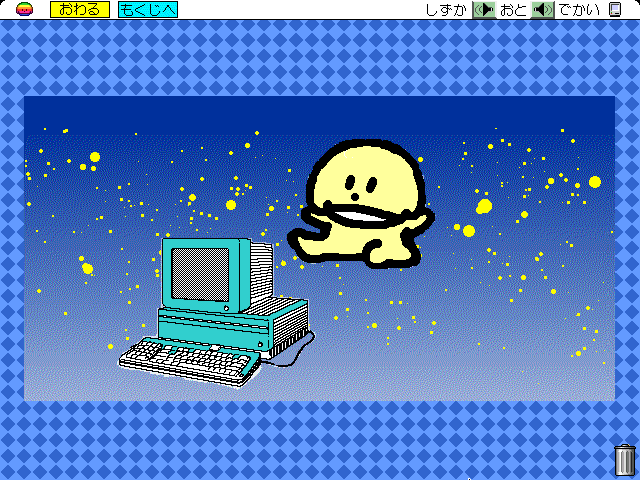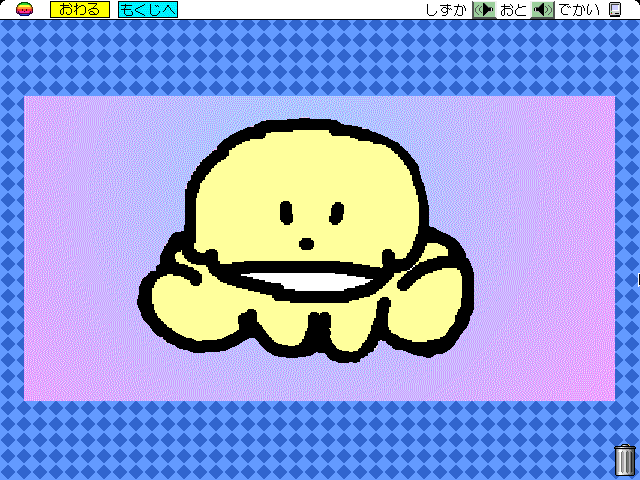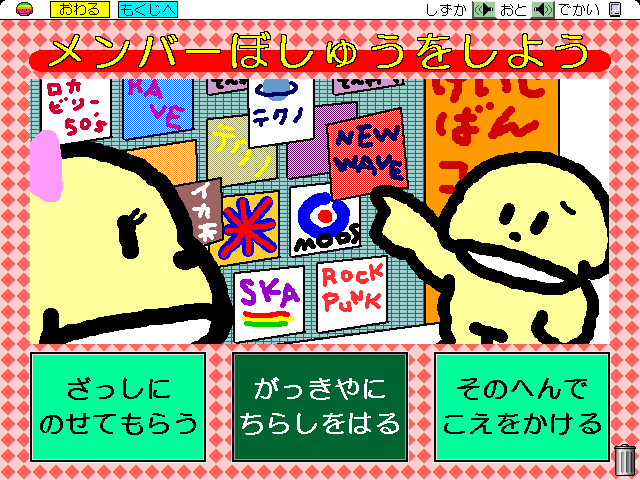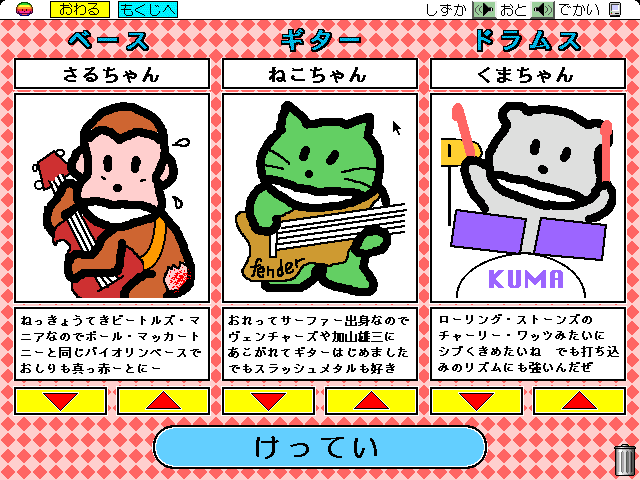Ganbare! Inuchan
— Inuchan's Song
More!! Compleat Inuchan (A-side), music and lyrics by Kenso Kato, 1988
What kind of music do you figure a dog would create if he had a band? This is the burning question answered by Kenso Kato's Ganbare! Inuchan: Rock'n Roll Edition, published by Amuse and Bandai's Emotion Digital Software for Mac and Windows in 1995.

Inuchan is a little dog who loves music. On his way home from karaoke one day, he hums himself a catchy little tune he's come up with and immediately suggests to his friend Mesuinuchan that they go back and sing some more. She patiently points out how much money he's spending on karaoke, and that maybe it would be cheaper to just start a band... and, well, why not?
But life isn't that easy for a little dog who wants to start a band. First of all they don't have any bandmates, and next of all they don't have any music either. None of that will stop Inuchan and Mesuinuchan though, and they'll drag the player along for the ride. Through awkward first steps, mediocre concerts and manic songwriting, breakups and reformations, Inuchan and Mesuinuchan have a tough journey ahead of themselves.

Kato has been called a "multi entertainer", having become a familiar face on TV, movies, radio, and commercials. He got a start in film with roles in Bumpkin Soup (1985) and Tampopo (1985), while playing a wide variety of TV roles from the mid-80s onward. As a DJ, he became a familiar voice on radio starting with his first role on Nippon Cultural Broadcasting in 1988, and he continued performing on a variety of stations for years to come.[1]
In the 80s, Kato was a member of new wave band Tokyo Towers alongside bandmate You-ichi Kishino[2]. Though they never recorded a full album, they had some local success performing live and several of their singles were collected on compilation albums, and they continued performing together as recently as 2014[3]. Kato eventually recorded a solo album in 1991, Waka-sa, Hitorijime, which combined new versions of Tokyo Towers's 1984 repertoire with new material. As a DJ, he was in a position to introduce the work of his indie peers to a wider audience, which he memorialized in the compilation album Trojan Horse; named after the radio program of the same name, it featured music from indie artists across all genres who had featured on his program—and, for good measure, a Tokyo Towers track.
Maybe his most enduring success, though, is creating the little dog Inuchan. He started making simple comics featuring an easy-to-draw dog character around 1984, simple gag strips that focused on his passions like music. His self-published doujinshi was a surprise success; Inuchan was officially picked up as a short-form strip in music and shojo manga magazines, and this version ran successfully for several years. At its height, different versions of Inuchan featured in four different magazines simultaneously. Inuchan's adventures centred on the music world. He and his friends were in a new wave band called the Animal Band, and the strips follow their daily lives both on and off the stage. They were surrounded by a supporting cast of human and animal characters, including an energy dome-wearing Kato.[4][5] Even after being picked up by magazines, Kato kept self-publishing; he even brought Inuchan into the music world with his zines The Compleat Inuchan (1987)[6] and More!! Compleat Inuchan (1988)[7], which bundled a set of original comics with a flexidisc containing original music in character as Inuchan.
Around 1990, Kato combined his love of the Mac with his comic and a new Inuchan was born. Drawn using simple graphical tools, the new MacPaint-esque art is intentionally crudely-drawn and instantly recognizable. Both Inuchans were designed to be crude and easily-imitatable, but the new pixel art Inuchan stands out in print as something distinctively different from anything else around him.

It's that digital Inuchan who shows up in Ganbare! Inuchan, animated and voiced by Kato himself. This is a storybook for adults, a grownup take on the interactive storybooks that were popular for children at the time. Divided into chapters like a book, each chapter brings them on a new adventure in their quest for stardom. In chapter 1, Inuchan decides to start the band and players must guide him and Mesuinuchan to the best way to find new members; chapter 2 has players practicing and coming up with new songs; chapter 3 has the band scoping out chances to have their first concert; and so on. They follow the simple set format of the children's games it's based on: each chapter begins with an animated introduction to the new problem set to music, followed by an animated and voiced scene depicting the story, and finally an interactive scene where players must try to solve the problem for themselves. Despite the silly premise and the superficially childish presentation, it's easy for adults to get invested in Inuchan's foibles and his band's fortunes. It helps that Inuchan and Mesuinuchan are so likeable, and their troubles so believable.
The minigames start out simple, and never reach a high level of complexity, but they remain engaging throughout. Their goal isn't to challenge the player, just to draw them into the world and ensure the player feels like an active participant in their journey.
The first chapter finds the fledgling band with zero members aside from Inuchan and Mesuinuchan. That's not going to get them very far, obviously, but where will they find members? This chapter's minigame features a simple multiple-choice prompt, letting players try out three different options: putting a "members wanted" ad in a local magazine; approaching a local street musician; and putting up a flier in the local music store. Taking out an ad nets them nothing but junk responses, and the guitar player on the corner turns out to already be far too famous and successful for the dogs' little band, but setting up a flier in the store gets them plenty of responses.

The result: more band members than they can handle! The second challenge of the first chapter, then: picking out band members. Drawing from the wide range of characters in the original manga, the game presents the player with a number of possible choices—but the player can only pick one character for each instrument! Who's available, and who'll get along?

Another memorable minigame, in chapter 2, has the newly-formed Animal Band practicing and getting their first songs together. The problem: they need to rent a practice space, and they only have so much cash, so the player has to help them budget. Given the choice between the high-class Platinum King at ¥5,000 an hour, the Asakusa Abbey Road at a more affordable ¥2,000 an hour, and the cut-rate Gotanda Panta at a mere ¥1,000 an hour, which will they choose? Is slumming with the spiders and cockroaches worth the savings? Will Inuchan and friends blow it all on luxury, then run out of time to practice? Once they actually get inside, players get to participate once more. Songs can be assembled from three pieces, with four choices for each, spanning different genres and musical styles. There's no requirement to stick with a single style for an entire song; there's freedom to experiment and see what sounds good. Each of the fragments is genuinely very catchy on its own, and they've been selected to ensure that many of the combinations will sound genuinely good. It encourages players to avoid striving for the "right" answer, and instead follow their gut and their inner musician to see if they can find something they simply like, for its own sake. Each try consumes one hour's worth of studio space rent and adds a few points to the player's total. If the player manages to hit 50 points without breaking the bank, they're able to pass on to the next chapter. Worth putting up with a cockroach or two, perhaps?

By the end of the game, both the plot and the minigames become more complex. The Animal Band finally gets it together and, after a chance encounter at one of their shows, gets the opportunity of a life time: an all-Japan tour! Inuchan and friends must make their way all around the country on their tour bus, hitting every stop for a performance along the way. The tour bus life is never easy though, and the minigame brings those frustrations home by transforming it into a board game. It takes the form of a sugoroku, a genre of Japanese racing board game similar to The Game of Life where players compete to reach the end of the board first. Here, there's no opponent except the vagaries of fate; players need to get the right dice rolls to hit every city on their journey, which can be frustratingly difficult since it all comes down to luck. Players might find themselves circling around a city for turns in a row before their lucky roll finally lands. But is that so different from the problems the band might run into on the road? Maybe you run into a flat with no garage nearby, maybe you run out of gas at a bad time. Many games might try to introduce themed squares, but Ganbare Inuchan realizes that mechanics can easily stand in for theme. The player's frustration, that eagerness simultaneously to just be over and to see what happens next, is thematic; the simple mechanics produce exactly the emotions the characters are feeling.
Yasukuni Notomi, a critic for the CD-ROM Critic Writers Association, was deeply moved at how genuinely realistic much of the story felt.[8] He points out that everything from the difficulty of recruiting members, to designing gig posters, to the heartbreak from the first concert failing, feels drawn from life. Each of Inuchan's struggles, and each of his little victories, felt to him like a moment from his teenage band years. Despite the cartooniness of the presentation, it's the underlying realism of the presentation, and the good-heartedness with which it treats the cast, that keeps him rooting for Inuchan to succeed in his wildest dreams. When the journey that takes him there is so relatable, it's easy for the player to vicariously share in his success.

One of the first things players will notice is that Kato's a huge Mac fan. The manual is filled with little comics about Macs—even before they start joking about CD-ROMs and playing the game, they're just a reminder of how important the platform is to the creator. It shines throughout the game itself, from the Mac-themed game UI, to the late-game nod to indie classic Pararena[9].
It's easy enough to dismiss this as just some 90s computer platform fanboyism, but a scene early in the game gives a hint that there's a little more depth here. When the Animal Band decide to have their first live show, Inuchan and Mesuinuchan are tasked with putting together a band poster. In a very cute sequence, players use what's functionally a little Mac desktop publishing program to design a simple band poster they can then take out to a copy store to be photocopied and pasted up anywhere they can. The player takes a step through the screen into Kato's world, seeing the Mac as object of creativity. The Mac, after all, isn't an object of worship on its own. It's a tool, and it's the tool that brought Inuchan and his world to life. The Mac, or any computer, offers the player the same chance.

Out of all the scenes of creativity, this minigame emphasizes it the most. The player's act of creating simple band posters on your home computer before photocopying them to distribute acts as a miniature summary of Inuchan's core aesthetic: Inuchan's band dreams, the simple collage-esque art, the game itself, all come down to a DIY ethos that suffuses everything about the game.
A similar ethos can be found in the motto of Trojan Horse, a compilation CD produced by Kato. "Hack! The Music", the cover proudly states, and the CD itself declares its existence as "The Ultimet[sic] Challenge to Music Industry".[10] This was a period of incredible excitement about the power of home computing and what it had made possible. It may be hard to remember now that we all hold computers in our pockets, at a time when TikTok is basically a free Adobe Premiere that runs on a phone, but there were whole worlds of art that were difficult to do without the right tools. A computer wasn't free, and not everyone had them, but it opened many doors that might have been closed.
Read through this lens, a lot of Inuchan's aesthetic quirks come into focus. The playful crudeness of the photo-montages, the copious use of stock imagery, the awkwardly-scaled champagne glasses held by Inuchan and Mesuinuchan in one scene... they're not just funny, though they're that too. They're quirks that remind you that "the tools that created this game are available to you". It's a message that the DIY spirit that suffuses this game can be yours, too. You can create.
Ganbare! Inuchan is out of print, but copies are occasionally available second-hand. It can be played on modern computers using the software ScummVM.
1. "テレビ・ラジオ・映画プロフィ-ル". kenso kato official web, https://toyromusic.com/kenso/PRO-B.html. ↩
2. BUGGLE. "K-Hin Bros. Co., Ltd." Pop Academy, https://technopop-academy.neocities.org/park10.wakwak.com/_techno/keihin.html#Tokyo%20Towers. ↩
3. Kato, Kenso. "東京タワーズ2010." かとうけんそう, https://www.toyromusic.com/kenso/tt2010.html. ↩
4. Kato, Kenso. (1995). いぬちゃん 1985-1993. Yamaha. ↩
5. Kato, Kenso. "いぬちゃん". kenso kato official web, https://www.toyromusic.com/kenso/inu.html ↩
6. "THE COMPLEAT いぬちゃん". Discogs, https://www.discogs.com/release/12216256-Kenso-Kato-THE-COMPLEAT-いぬちゃん ↩
7. "More!! Compleat いぬちゃん". Discogs, https://www.discogs.com/release/8512855-Kenso-Kato-More-Compleat-いぬちゃん ↩
8. Notomi, Yasukuni. "がんばれいぬちゃん、ロケンロール編". CD-ROM Almanuc. http://www.textlife.net/ccwa/CDROM/cdroms/G01.html#k9. ↩
9. Thanks to Twitter's RavenWorks for pointing this out when I streamed Inuchan last year. ↩
10. Kato, Kenso. (1993). Trojan Horse [CD]. Tokyo: ¡Por supuesto! ↩